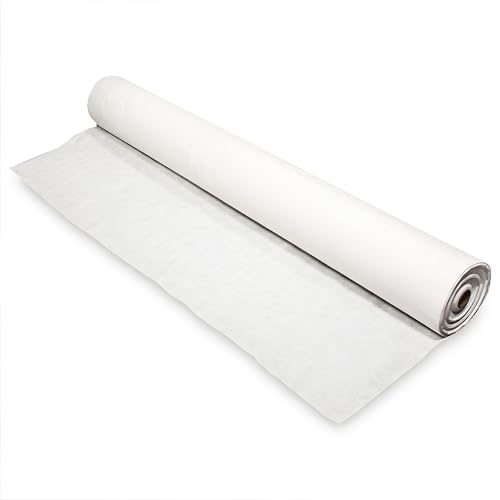
Creating a neat edge around your lawn not only adds a touch of elegance to your outdoor space, but it also helps to define the boundaries of your lawn and prevent grass from encroaching into surrounding flower beds or paths. While there are many tools available for creating a lawn edge, using a spade is a cost-effective and efficient method that can be easily mastered by beginners.
Step 1: Prepare the area
Before diving into the task, it’s important to prepare the area by removing any debris, stones, or weeds along the edges of your lawn. Clearing the area will ensure a clean and precise edge.
TIP: It’s beneficial to wet the ground slightly, as this will make it easier to cut through the turf with the spade.
Step 2: Choose the desired edge
Decide on the type of edge you want for your lawn. You can opt for a straight edge, a curved edge, or even a wavy edge for a more natural look. Once you have decided, mark the outline of the edge using a string or a garden hose. This will help you visualize the end result and make it easier to follow while cutting.
Tools needed for creating a neat edge around lawn
To create a neat edge around your lawn, you will need a few tools to help you achieve a professional-looking result. These tools will make the process easier and ensure you have a clean and defined edge.
1. Spade
A spade is an essential tool for cutting and removing the grass or soil along the edge of your lawn. Choose a spade with a sharp, straight blade that will easily slice through the turf. A spade with a long handle will provide more leverage and make the job less strenuous.
2. Half-moon edger
A half-moon edger, also known as an edging iron or a lawn edger, is a specialized tool designed specifically for creating clean edges. It has a semicircular blade that you can push into the ground along the edge of the lawn to create a neat and precise cut. This tool is perfect for maintaining straight lines and achieving a professional finish.
For optimal results, you can use a combination of these tools. Start by using the spade to remove any excess grass or soil, and then follow up with the half-moon edger to create a clean and defined edge.
Selecting the right spade
When it comes to creating a neat edge around your lawn with a spade, selecting the right tool is essential. Here are some factors to consider when choosing a spade:
Type of spade: There are different types of spades available, including flat spades, half-moon spades, and step edgers. Each type has its own advantages and is suited for specific tasks. Consider your specific needs and preferences before making a decision.
Size and weight: The size and weight of a spade can greatly affect its usability. A spade should be comfortable to hold and maneuver while still being sturdy enough to handle the task at hand. Consider your own strength and the size of your lawn when choosing the size and weight of your spade.
Material: Spades are typically made from either steel or stainless steel. Steel spades are more common and generally more affordable, but they may rust over time. Stainless steel spades are more durable and resistant to rust, but they tend to be more expensive. Consider your budget and the durability you require when choosing the material of your spade.
Handle: The handle of a spade should be comfortable to grip and provide good leverage. Look for a spade with a handle made from a sturdy material such as wood or fiberglass. Some spades also come with ergonomic handles that offer extra comfort during use.
Price: Spades can vary in price depending on their quality and features. Set a budget for yourself and choose a spade that offers good value for money. Remember, a high-quality spade can be a long-term investment that will save you time and effort in the long run.
Take the time to research and test out different spades before making a decision. By selecting the right spade for your needs, you’ll be on your way to creating a neat and professional-looking edge around your lawn.
Preparing the area for edging
Before you can begin creating a neat edge around your lawn with a spade, it’s important to properly prepare the area. This will ensure that the edging is clean, straight, and long-lasting.
1. Mark out the area
Start by marking out the area where you want to create the edge. This can be done using string or a garden hose to outline the desired shape. Take into consideration any existing edges or boundaries, such as walkways or flower beds, to ensure a seamless transition.
2. Clear the area
Remove any obstacles or debris from the marked-out area. This includes rocks, sticks, or excessive grass clippings. You want a clear and smooth surface before starting to edge.
3. Measure and plan
Take measurements to determine the depth and width of the edge. Use a tape measure or ruler to ensure uniformity and precision. Consider the overall design of your lawn and the desired look, whether you want a subtle or defined edge. Planning ahead will help you achieve the desired result.
4. Dig a shallow trench
Using a spade, dig a shallow trench along the marked-out area. Make sure the trench is consistent in depth and width, following your measurements. Take your time to maintain a straight and even line.
5. Remove excess soil
Once the trench is dug, carefully remove any excess soil from the area. This can be done by hand or using a small gardening shovel. Smooth out the edges of the trench to create a clean appearance.
By following these steps, you will have properly prepared the area for edging. This will ensure that your lawn looks neat and well-defined, adding curb appeal to your outdoor space.
| Tools Needed: | – String or garden hose |
|---|---|
| – Spade | |
| – Tape measure or ruler | |
| – Small gardening shovel |
Creating the edge with a spade
To create a neat edge around your lawn using a spade, follow these steps:
- Start by removing any existing grass or weeds along the edge of your lawn. This will help create a clean line.
- Using a spade, dig a shallow trench along the edge of the lawn. Make sure the trench is about 3-4 inches deep.
- As you dig, angle the spade away from the lawn to create a slight bevel. This will help prevent grass from growing into the garden bed.
- After creating the initial trench, use the spade to smooth out the edge and remove any loose soil or debris.
- Once the edge is defined, you can use an edging tool or hand shears to trim the grass along the edge, creating a clean and uniform line.
- To maintain the edge, regularly check for any grass or weeds that may be creeping into the garden bed and remove them promptly with the spade.
- Tip: It’s best to create the edge when the soil is slightly moist. This will make it easier to dig and maintain a clean edge.
By following these steps and using a spade, you can create a neat edge around your lawn, giving it a polished and professional look.
Maintaining the neat edge
Creating a neat edge around your lawn is only the first step in achieving a pristine look. In order to keep your lawn looking sharp and well-maintained, regular maintenance is crucial. Here are some tips for maintaining the neat edge:
- Trim regularly: Use a lawn mower or trimmer to regularly cut the grass along the edge of the bed. This will prevent the grass from encroaching into the edge and keep it looking clean.
- Remove weeds: Keep an eye out for any weeds that may be growing along the edge. Remove them regularly to prevent them from spreading and overtaking the area.
- Edge with a spade: Periodically re-edge the lawn using a spade to redefine the straight edge. This will help maintain the sharp boundary between the lawn and the surrounding beds.
- Apply mulch: Apply a layer of mulch along the edge of the bed to help suppress weeds and give the area a polished look.
- Monitor soil erosion: Keep an eye on the edge to ensure that the soil is not eroding away. If you notice any signs of erosion, address it immediately to prevent further damage.
- Regular watering: Properly water the lawn and bed areas to ensure that the grass stays healthy and lush. This will also help prevent any gaps or uneven edges from forming.
By following these maintenance tips, you can ensure that your neat edge remains a defining feature of your lawn, enhancing its overall appearance.
Tips for achieving a perfect edge
Creating a neat edge around your lawn not only enhances the overall appearance of your garden but also helps to keep the grass from creeping into your flowerbeds or walkways. Here are some valuable tips to help you achieve a perfect edge using a spade:
- Plan and mark your edge: Before starting, visualize the desired shape and line of your edge. Use a string line or hose to mark the area you want to edge.
- Choose the right time: It’s best to edge your lawn when the soil is slightly moist. This will make the digging process easier and help create cleaner cuts.
- Use a sharp spade: A sharp spade will make all the difference in creating a clean and precise edge. Dull blades can tear the grass instead of cutting it.
- Start digging: Position the spade vertically at a slight angle, with the blade touching the grass. Push the spade into the soil, using your foot to apply pressure if needed. Make sure to maintain a consistent angle as you work around the edge.
- Remove excess soil: After cutting along the marked line, carefully remove any extra soil or grass from the newly created edge. This will help define the shape and make it more noticeable.
- Maintain the edge: To keep your lawn looking pristine, regularly trim and maintain the edge. This will prevent the grass from overgrowing and encroaching on the surrounding areas.
With these tips in mind, you’ll be able to create a perfectly neat edge around your lawn, giving your garden a polished and professional look.






